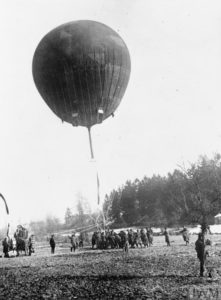Friday May 24th, 1918
Night work – 8 o’clock till 12am. No day work. Very hot again. Canteen stuff up – very little. Wrote home.
Enemy Observation Balloon

Today, an enemy observation balloon was spotted and recorded in the Battalion’s diary. Apparently the phrase ‘The balloon’s going up’, which signals that something awful is about to happen, had its origins in the context of observation balloons.
In WWI both sides used them, mainly to improve and monitor the accuracy of the artillery. By being elevated, a balloon’s occupants had a much better view over the yards and miles of a shell’s trajectory. Therefore if a balloon was spotted, it usually meant that the artillery was preparing for an offensive.¹
The photograph is of a German Parseval-Siegsfeld type balloon at Équancourt in September 1916. The rear “tail” fills with air automatically through an opening facing the wind.*
History of the Balloons in War

In 1783 French brothers, Joseph and Etienne Montgolfier, were the first people to ever fly in a hot air balloon. It is therefore fitting that balloons were first used for military purposes during France’s Revolutionary Wars just over ten years later.
Both sides used them in the American Civil War and Britain used them during various African campaigns in the late 19th century, including the Second Boer War. In all these conflicts they were used to take photographs and make sketches of positions and to direct artillery fire. These remained their primary function during WWI.
Despite their head start, Britain and France, at the beginning of WWI, were still deploying spherical balloons that were not particularly aerodynamic or useful in bad weather. The photograph shows French troops launching an observation balloon somewhere on the Western Front in 1914.
The Germans addressed these failings when they developed the kite balloon (as illustrated above). The French soon followed with the Caquot kite balloon which was adopted by the Allies in the later half of the war.
Throughout the war, all balloons were filled with hydrogen and were therefore highly flammable. Their crews were equipped with parachutes and the balloons themselves defended by both anti-aircraft crews and aeroplanes.
13th (Service) Battalion War Diary – 24th May 1918 – Sporan
Our artillery only slightly active. Enemy fired several light shells on Goldies III, Turtle Ravine and Single Tree Hill. Our planes did their usual patrolling. One enemy plane passed high over our lines at 17:50 hrs. Patrols posted proclamations on Dautli. Noises evidently made by transport were heard behind Dugout Hill. Work is being continued on west dugout on Devedzelli Spur. Enemy observation balloon was up during the evening. The undermentioned embarked for UK 6-5-18 to join Officer Cadet Unit (Auth SA No 13846 dated 22-4-18) Number 6143 Corporal Mitchell W, D Coy, 6147 Corporal Roderick J, A Coy.
References & Further Reading
¹ Observation Balloons on Wikipedia
* German observation balloon. This image file was donated by Europeana to Wikimedia Commons.
² The History of Hot Air Balloons
^ Q 53519, copyright Imperial War Museums



One thought on “Observation Balloon – May 24th, 1918”
Comments are closed.